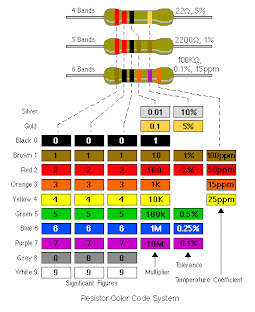Current Limiting Resistor Calculator for Leds
-
If you want to calculate Resistor, please visit Here!
Some good values to try:
As supply voltage:
For molex: 5, 7 and 12 volts
Batteries: 1.5 and 9 volts
...
2:49 PM
Resistor Colour Codes
CjAngel
Learn how to identify different resistors with their colour code
 The humble resistor is a key component of many renewable energy systems. They are designed to resist electricity and can therefore be used to supply the correct voltage to the various components in an electric circuit.
The humble resistor is a key component of many renewable energy systems. They are designed to resist electricity and can therefore be used to supply the correct voltage to the various components in an electric circuit.
Because resistors are so small - too small to print numerical resistance values on - they are instead marked with four, five, or (less commonly) six coloured bands. Each colour represents a different number and so the value (in Ohms) of the resistor can easily be calculated.
The last coloured band is usually used to indicate the tolerance - a measure of how accurate the stated resistance is, i.e. 1%, 2%, 5%, or 10%. In the case of six band resistors, is used to show the temperature coefficient - a measure of how much the resistance of a resistor is changed by changes in temperature.
Remembering the Resistor Colour Code Values
There are many mnemonic phrases to help you to remember the order of the colours:
Black Brown Red Orange Yellow Green Blue Violet Gray White
...which correspond to the values 0-9. For example:
Bad Beer Rots Our Young Guts But Vodka Goes Well.
 The humble resistor is a key component of many renewable energy systems. They are designed to resist electricity and can therefore be used to supply the correct voltage to the various components in an electric circuit.
The humble resistor is a key component of many renewable energy systems. They are designed to resist electricity and can therefore be used to supply the correct voltage to the various components in an electric circuit.Because resistors are so small - too small to print numerical resistance values on - they are instead marked with four, five, or (less commonly) six coloured bands. Each colour represents a different number and so the value (in Ohms) of the resistor can easily be calculated.
The last coloured band is usually used to indicate the tolerance - a measure of how accurate the stated resistance is, i.e. 1%, 2%, 5%, or 10%. In the case of six band resistors, is used to show the temperature coefficient - a measure of how much the resistance of a resistor is changed by changes in temperature.
Remembering the Resistor Colour Code Values
There are many mnemonic phrases to help you to remember the order of the colours:
Black Brown Red Orange Yellow Green Blue Violet Gray White
...which correspond to the values 0-9. For example:
Bad Beer Rots Our Young Guts But Vodka Goes Well.
